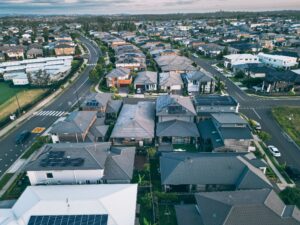Mirvac Group Ltd
(ASX: MGR)Share Price and News
About Mirvac Group
Mirvac (ASX:MGR) is an integrated real estate group with a diversified portfolio across residential development, commercial office, retail, and industrial assets, primarily located in key Australian cities including Sydney, Melbourne, Brisbane, and Perth.
As of December 31, 2024, the company reported an investment portfolio valued at over $10 billion, with the majority allocated to office and retail assets that generate recurring rental income.
Mirvac also maintains a residential-focused development pipeline, providing a significant runway for earnings growth. This is not just developments that will be sold, but Build-to-Rent (BTR) apartments. Mirvac may well be the best opportunity for investors wanting exposure to this space.
MGR Company History
Mirvac was founded in 1972 by Robert Hamilton and Henry Pollack. The latter was a Holocaust survivor who came to Australia amidst World War Two and paid his way through an architecture degree by running a dress shop. The former was one-time medicine student who decided to become a real estate agent. Hamilton, who was advising companies on how to go about developments got the urge to do it himself.
After 2 years of going at it alone, he met Pollack as a would-be prospect to sell a building, but the pair left with a deal for Hamilton to find Pollock build-to-sell development sites. The first development was Montrose, a block of 12 apartments in Rose Bay.
Initially the company focused on inner city areas, but in the late 70s pivoted to home and land packages in the growing outer suburbs of Sydney and to commercial developments. The first of the latter was 'The Landmark' which was completed in 1980. 1987 saw the company's IPO.
The 1990s and 2000s saw more developments, most famously an urban renewal of Melbourne's Docklands area, the redevelopment of Waverley Park, the renewal of Burswood in Perth and Walsh Bay in Sydney - the latter was so popular that $400m in real estate was sold in a single day upon its release.
2005 was a key year with the company merging with James Fielding, in a $478m deal that enabled Bob Hamilton to retire (Pollack retired in 1996 and passed away in 2005). Initially, JFG boss Greg Paramor took the reigns only to hand it to Nicholas Collishaw in 2008 just prior to the GFC, and he served until 2012 when Susan Lloyd-Hurwitz took over.
Under her tenure, the company became more focused on medium to high density residential/commercial projects in inner cities and one of the first projects under her watch was the renewal of Glebe's Harold Park. The company has also placed more of an emphasis on sustainability including having minimal carbon usage and being water efficient.
In the latter half of her tenure, Mirvac saw an opportunity in the Build to Rent (BTR) space, thinking it could work in Australia as it did in other countries. It has taken longer than expected to get things off the ground, but the first BTR community was launched in 2020 (LIV Indigo). In 2021, it became the first property company to become carbon positive (9 years ahead of schedule). Lloyd-Hurwitz retired in 2022 and was replaced by Capbell Hanan.
Future Outlook of Mirvac Group (ASX: MGR)
In our view, the key reason to buy Mirvac would be for exposure to the BTR sector. Mirvac is a first mover here and while it has taken longer than it should've for it to get started, things are on track now.
We think it could be the biggest innovation in Australian housing since the creation of strata. This business model is well established in other Western jurisdictions – worth 12% of housing stock in the US. It is less so in Australia, at >1% of completed housing stock as of last year.
Large scale build to rent apartments can generate large returns for investors because renters pay a premium to use these apartments – they tend to be furnished with facilities such as pools, gyms and other communal spaces. And these are the reasons why renters like them – they are willing to pay a premium for them. The name of a renowned company carries more weight than some anonymous landlord, doesn’t it? Mirvac now has over 1,000 operational apartments with more to come.
However, the company has a difficult short-term outlook as many of its sectors face issues. The office space has (and continued to be) impacted by people working from home. Residential developments have faced supply chain issues and rising interest rates. In FY24, the company made 14c per share in operating earnings and has told investors to expect 12.3c in FY25.
CEO Campbell Hanan blamed a lower contribution from the development business and higher net interest costs related to development activities but said better times were ahead.
‘There is significant value to play for and multiple drivers of earnings growth in FY26 and beyond,’ he said noting there were some green shoots in market activity, particularly higher pre-sales.
Is MGR a Good Stock to Buy?
Mirvac may suit investors with a medium-term outlook who seek exposure to the BTR sector, but we would not recommend buying until it issues its FY25 results. Not just because they are expected to be a retreat, but also because the company will give investors an indication of what to expect in FY26.
Our Stock Analysis
Is Lendlease (ASX:LLC) out of the doldrums for good?
Lendlease (ASX:LLC) has for the past several years been the classic definition of a ‘value trap’. You think a good…
Build to Rent Apartment Construction is on the rise! Here’s how to access this sector on the ASX
For years, investors have heard hype about the Build to Rent, but the hype has not matched reality…until now. …
As lower interest rates loom, here are 6 ASX stocks that will benefit from forthcoming rate cuts
Here 6 ASX stocks that will benefit from lower interest rates! AGL Energy (ASX:AGL) You might think AGL is…
Mirvac (ASX:MGR): Things are set to get worse before they get better
Founded in 1972, Mirvac (ASX:MGR) is Australia’s largest listed developer of residential, commercial and industrial property. Arguably, it is one…
Frequently Asked Questions
The company's largest shareholders are custodian shareholders including BlackRock, State Street and Colonial who have shares on behalf of others.



